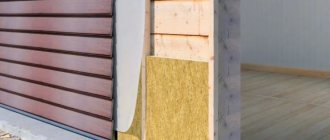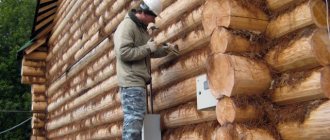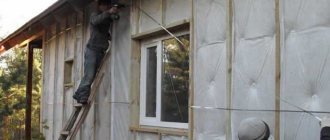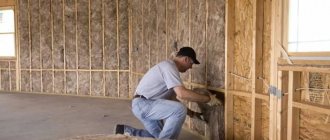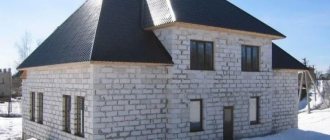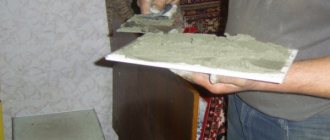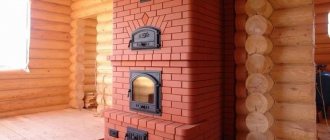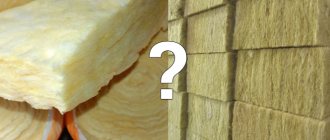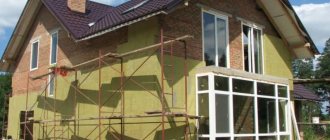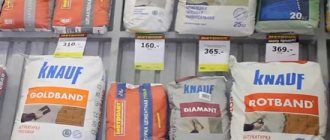Currently, mineral wool is one of the most popular insulation materials. It is used for various surfaces and jobs. At the same time, stone wool for facade insulation is rightly among the priority insulators.
The basis for stone wool is basalt. Therefore, the material is also called basalt wool. Production technology allows us to obtain mineral insulators of different types, as well as with different characteristics. It is actively practiced to insulate a wooden house from the outside with mineral wool under the siding. But this insulator is also excellent for concrete, brick, and various block walls.
Also, facade insulation with mineral wool (stone) is in demand due to the safety and environmental friendliness of the material itself. There are no harmful or dangerous resins here. Only natural ingredients. In addition to its thermal insulation properties, the material also insulates well from extraneous sounds.
What you need to know about insulating a wooden house
Wood is different from all other natural and artificial building materials. In its natural state, it is a network of capillaries through which the “organs” of a living organism are nourished. After the tree is cut down, sanded, processed and during the shrinkage of the finished structure, the wood is dried to a moisture content level of 16-20%.
Drying is never complete. Moreover, it is reversible - when there is excess humidity, water vapor is absorbed from the air. In addition, wood is a “breathable” material, especially along the grain. This means that air is exchanged between the room and the street at the level of gas diffusion through the wall structure. This ability of a wooden house to self-regulate the microclimate is most valued.
Facade surface preparation
Before starting to work with insulation and plaster, it is necessary to clean the surface of the walls from oil stains and dirt and level them. According to technology, all metal elements that may rust must be removed from the walls outside. If these are strategically important metal elements, then it is necessary to ensure the flow of oxygen under the plaster, i.e. this immediately excludes the use of acrylic-based plaster.
The insulation material must have low thermal conductivity. Therefore, mineral wool, namely its variety with a density of 140 kg/m², is ideal.
If there are remnants of the old coating on the walls, be it paint, plaster or anything else, then insulation cannot be placed under the plaster.
Before starting insulation, it is worth using sags to mark the boundaries of the zones. Sags are strong nylon cords pulled between the reinforcement pins (these pins must then be removed, so do not drive them in too tightly), fixed at a designated point in a vertical, horizontal position and diagonally.
Sags are installed to assess the geometry of the wall
Once the sags are in place, it becomes much easier to evaluate the wall geometry. The sags must be attached so that they retreat at least 1 cm from the mineral wool. After the wall is marked, you can begin installing the guide profiles.
Video description
We will dwell in more detail on insulating a house with polystyrene foam.
Find out how safe polystyrene foam is in our video: The wrong choice of insulation or protective membranes in the design of a curtain wall disrupts both processes. But if the loss of “breathing” properties is compensated by a supply and exhaust ventilation device, then with moisture transfer everything is much more complicated. In winter, when the partial pressure of water vapor inside the house is greater than outside, it enters the walls of the house.
The wrong choice of technology and materials leads to the appearance of excess moisture in the thickness of the wall, which is poorly evaporated Source stroim-dom.radiomoon.ru
Of course, some of the excess moisture from the air will go into the ventilation system, but the rest will penetrate into the capillary structure of wooden structures. And if they are not dried, the tree is literally saturated with water. In addition, where there is dampness, favorable conditions are created for the growth of fungus and mold.
For reference! Moisture transfer is the movement of moisture in capillary-porous bodies from a saturated zone to an unsaturated one.
Pros and cons of using mineral wool for external thermal insulation of a house
The popularity of insulation is primarily due to:
- low thermal conductivity of the material, and therefore high thermal insulation characteristics;
- excellent sound insulation;
- good level of fire safety (after all, mineral wool does not support combustion);
- vapor permeability (provides “breathing” of the house, which is especially important if the house is not wooden, but stone);
- resistance to fungi and rodents;
- relative environmental friendliness and safety of the material (harmful substances are released only when heated to more than 300 ° C);
- simplicity of installation technology.
Thermal insulation of the facade using mineral wool can be done independently
As disadvantages it is worth noting:
- change in the volume of insulation and the appearance of cracks in it (occurs only when there is no reinforcing layer);
- If mineral wool is not treated with a hydrophobic solution, all its thermal insulation characteristics will come to naught, because it almost instantly absorbs moisture.
Benefits of mineral wool
Brick or monolithic houses can be insulated with any thermal insulation materials. The choice of insulation for a wooden house is not so extensive. Expanded polystyrene, EPS or spray polyurethane foam are not suitable here. All these materials have a porous structure with closed cells, and although this structure provides high thermal insulation properties, it almost completely blocks the diffusion of gases, and especially steam.
Thermal insulation materials based on stone wool are best suited for a wooden house. There is nothing new in the use of cotton wool for wooden house construction - and now the inter-crown cracks of log houses are caulked with natural materials consisting of plant fibers.
Often, cotton wool-based materials are used for caulking Source www.znaikak.ru
There are also insulation materials in the form of mats made from natural raw materials - hemp, flax and even wool. But they are easily spoiled by insects and microorganisms, moreover, they are expensive and not durable, so they are not suitable for external insulation. Stone wool is used to insulate the facade.
Costs of raw materials and services
Material costs are determined by the insulation area and depend on the size and cost of the slabs. With a total insulation area of 109.9 m2, a thickness of the slab layer of 0.1 m, the volume of the heat insulator will be 11 m3.
Since most insulation is sold in m3, knowing its cost, you can determine the total cost of purchasing slabs:
- Basalt wool, 1500 rub/m3, total 16500 rub.
- Mineral wool, 1070 rubles/m3, total 11770 rubles.
- TechnoNIKOL basalt wool, 2270 rub./m3, total 24970 rub.
- Glass wool Isover Warm House, 1250 RUR/m3, total 13740 RUR.
- Stone wool Mat Teploroll, 1280 RUR/m3, total 14080 RUR.
- Slag wool, 860 rub./m3, total 9640 rub.
- Ursa GEO Facade, 975 rub./m3, total 10,725 rub.
The cost of work on thermal insulation of a brick house depends on the following factors: the type of materials used, the area of thermal insulation of wall structures, the height of the house, transport interchange in the construction area, finishing method, technical condition of the surface, period of year.
Average prices by region of Russia for thermal insulation of brick walls:
- thermal insulation with mineral wool on glue, 360 RUR/m2;
- fiberglass reinforcement and glue treatment, 410 RUR/m2;
- primer work, 60 rub./m2;
- performing decorative plaster, 380 RUR/m2;
- thermal insulation with mineral wool on a wooden frame, 870 rub./m2.
If you are interested in how and with what you can insulate brick walls from the inside and outside, take a look at this section.
Types of mineral wool
Glass wool . It belongs to the “old-timers” of mineral wool inorganic insulation. Glass wool is made from the same raw materials as glass itself - quartz sand and broken glass. This material is environmentally friendly, non-flammable and inexpensive. But there are also significant disadvantages:
- low dimensional stability, insulation is difficult to install in a vertical structure. There is a risk that during operation the glass wool will slide down.
- active absorption of moisture from the surrounding air, which worsens the heat-shielding properties of glass wool during operation
Glass wool caulking for inter-crown cracks Source nkkconsult.ru
See also: Catalog of companies that specialize in insulating country houses.
Slag wool has another drawback - the poor environmental qualities of the raw material itself. When wet (and the penetration of water vapor into the insulation is inevitable), a moist acidic environment is formed, which is harmful both to the wood itself and to the metal fasteners of the siding.
The crowns are caulked with slag Source stroim-dom.radiomoon.ru
The only option left for insulating a wooden house from the outside under siding is stone wool . This is an environmentally friendly product obtained as a result of rock melt. Stone wool has a fairly low thermal conductivity coefficient, it allows steam to pass through perfectly and is a non-combustible material, which is extremely important for wooden houses.
Caulking inter-crown cracks with stone wool Source es.decorexpro.com
Unlike “natural” wool, mineral fibers are not wetted by water. It is important to ensure ventilation conditions, although this is also necessary for the normal operation of the tree itself.
For reference! There are special modifications of hard stone wool mats that are used as an element of fire protection structures.
Types of insulation for siding for a brick house
- Mineral wool with different densities. Mineral wool, which can be bought in building materials stores, where it is sold in rolls or slabs.
- Glass wool, which is made from fiberglass. Due to its low cost, it is in high demand among owners of private houses.
- Foam plastic, extruded polystyrene foam. This type of insulation is also often used to insulate a brick house.
- Basalt wool (or stone) is made from minerals that melt during the manufacturing process and form a heat-resistant material.
Each of these insulation materials has certain properties, so before purchasing, it is recommended that you familiarize yourself with the physical properties of the insulation and its chemical composition.
Physical indicators include:
- Thermal conductivity coefficient, which has its own value for each insulation;
- Indicator of vapor permeability and moisture resistance;
- Heat resistance indicator.
Selection of materials
Selection of stone wool
Companies that insulate low-rise buildings usually work with a specific brand of stone wool, but the customer has the right to change the insulation used for the construction of the facility.
Now many “experts” suggest choosing insulation based on density, limiting yourself only to this parameter. In particular, to insulate the outside of a house with stone wool under siding using curtain-wall facade technology, it is proposed to use semi-rigid mats with a density ranging from 45 kg/m3 to 125 kg/m3. Insulation in this range is not elastic and will be poorly mounted into the frame, and often simply break during installation. Therefore, when choosing stone wool, you need to pay attention to the following parameters:
- Thermal conductivity . The lower this figure, the better, since the insulation conducts less heat, and the home owner will pay less for the operation of the house (not only in winter but also in summer, when the house needs to be cooled)
- Thickness _ It is selected based on the thickness of the original wall and the climatic conditions of the region in which the house is located.
- Elasticity . The insulation will be installed in the spacer between the studs of the wall frame. Therefore, only elastic insulation can be installed efficiently, without using additional fasteners and eliminating air / non-insulated “pockets”.
Calculation of the amount of heat insulator
The calculation begins by determining the surface area of the brick walls . To do this, they take as a basis the formulas of perimeter and area. The surfaces of the openings of windows and doors are subtracted from the result obtained.
For example, for a house with dimensions of 10x10 m in plan, with a wall perimeter of 40 m and a height of 3 m, the area of 4 standard windows with a height of 1.35 m and a width of 1.20 m will be: 4x1.35x1.20 = 6.48 m. The area of a standard doorway is equal to: 2x2.0x0.9=3.6 m. Total insulation area: 40x3-3.6-6.48=109.92 m2. The volume of mineral wool with a thickness of 100 mm will be: 110x0.1=11 m3
Video description
In simple words, the calculation of insulation thickness is described in the following video:
Frame materials
Both types of materials are used for lathing: galvanized metal profile and wooden beams.
The use of metal profiles is provided for in all factory-made hinged facade systems. Dimensional stability, clear geometry of unified forms - all this is ideal for industrial replication and development of installation flow sheets. But they have one drawback - the metal serves as a “bridge” of cold and reduces the thermal insulation properties of the curtain wall. Even the standard for thermal protection of buildings has an unambiguous recommendation for minimizing metallic inclusions in insulation. And if you can’t do without fasteners, then the sheathing can be made of wood.
Wood is more “capricious” and heterogeneous in its structure. Lumber may “lead” during storage, which leads to a change in shape. There are knots, resin pockets, cracks and almost a dozen other defects specified at the standard level. But despite this, timber sheathing is often used for cladding wooden houses. Although this requires certain selection and pre-processing of the material.
Wooden beams are often used as a frame for insulation. Source pro-uteplenie.ru
How to insulate a house outside with mineral wool
Over the years, and after numerous cycles of changing temperature conditions, the outer wood covering has lost its original properties. This is due to the fact that a large number of large, deep cracks appear on wood material, namely logs or beams, under the influence of various atmospheric changes.
It follows from this that in most cases, mineral wool is chosen to insulate the facade of a wooden house, and vinyl siding is chosen for the decorative outer surface. Which is not very expensive in price and has a fairly long service life.
And yet, the finishing material is easy to install and, if one of the panels is damaged, it can be easily replaced with a new one. The technology of such insulation has advantages that make it particularly unique and individual:
• respect for the environment;
• fire resistance (it increases fire safety outside the house);
• the ability to perform any work regardless of atmospheric changes (strong tropical torrential rains are an exception; when choosing to work with cotton wool, the entire material will most likely become wet);
• ease of installation;
• materials (siding and mineral wool) have vapor permeability properties.
For full effect, the design must have at least one of four insulating layers: insulation; wet membrane; wind protection. All installation materials are mounted on a frame, a specially prepared metal or wooden profile. It is this installation that protects the wood from excess moisture and allows the walls to “breathe.”
Insulation technology
Work on insulating the outside of a house with mineral wool under siding has a standard sequence:
- preparation of the base;
- installation of a supporting frame for siding;
- installation of stone wool in the frame;
- fastening a vapor-permeable protective membrane;
- siding installation.
Note! Installation of a vapor-proof film between a wooden wall and insulation is not carried out. Such a barrier will disrupt the conditions for weathering excess moisture from the wood. insulating the house outside with mineral wool under the siding.
Preparatory work
The stage of preparing the facade of a wooden house for siding is as follows:
- cleaning from dirt, dust and traces of biological damage;
- surface inspection and identification of problem areas;
- treating external walls with an antiseptic;
- caulking cracks, sealing cracks with wood sealants;
- taking measurements and marking the fastening of load-bearing elements of the sheathing.
Insulation on the frame
Frame insulation of a wooden house from the outside with mineral wool under siding can be carried out in one or two layers.
If insulation is carried out in several layers, then each of them has its own frame Source karaokerox.ru
If the estimated thickness of the insulation is no more than 50 mm, then frame technology for attaching mats in one layer is used. This method involves laying stone wool between the wooden sheathing, and creating a ventilated gap and fastening the siding using a counter-lattice.
Before starting work on installing the frame, all wooden elements must be treated with an antiseptic.
Then, in accordance with the markings, the vertical sheathing is attached. The spacing of the timber is chosen slightly less than the width of the insulation so that it fits in with little effort. The alignment of the timber is carried out at two levels - vertically and in the plane of the wall. The cross-section of the beam does not have to be square, but its height must be equal to the thickness of stone wool, and its width must be at least 50 mm.
After laying and fixing the insulation, a vapor-permeable windproof membrane is attached to the sheathing.
Note! For stone wool mats laminated with fiberglass, a membrane is not needed.
If the insulation is laid in one layer, then a counter-lattice is vertically attached to the sheathing of the first tier on top of the membrane. To do this, use a beam with a cross section of 50x50 mm.
Siding is attached directly to the counter-lattice Source rubankom.com
It is important! According to the current regulations, the ventilated gap must be at least 50 mm - otherwise the ventilation may not cope with its task.
There are more complex designs of wooden sheathing for frame technology for attaching insulation. They are used when mats are attached in two layers:
- the first layer is mounted using vertical lathing;
- the second layer is placed between horizontal rows of timber, packed on top of the vertical sheathing;
- Siding installation is carried out along a vertical counter-lattice.
Frameless insulation technology
If the slabs are significantly thick and insulated in one layer, the slabs are mounted as a continuous flooring, and the supporting frame for the siding is mounted on brackets. This is a universal technology that is suitable for both wooden beams and metal profiles.
The height of the brackets is selected taking into account the thickness of the insulation and the size of the ventilated gap. The fastening step depends on the type of siding.
Frameless fastening of insulation Source es.decorexpro.com
Stone wool slabs are attached to the facade itself in such a way that they are located as closely as possible to each other. Fixation occurs using disc-shaped plastic dowels and wood screws.
Then a windproof membrane is attached on top of the insulation using the same “fungus” dowel with a spacer plastic rod, which should pass through the entire layer of insulation.
Possible difficulties and errors during the installation process
In fact, modern thermal insulation boards are produced in such a way that even novice craftsmen can install them on their own .
The problem arises in obtaining a real result in conserving thermal energy in the house during the winter period and ensuring normal thermal conditions during the hot period. To do this, you need to choose the right thermal protection system.
Since it is an expensive undertaking, it is better to invite specialists before installation, who, using instruments, will be able to establish the real heat loss in the cottage, and select a protection system: the type of slabs and its thickness, installation and finishing technology.
If this is not done, then installing thermal protection may not bring the desired result, and sometimes even cause harm if the dew point is shifted and moisture begins to destroy the structure of the walls and foundation of the house.
Thermal calculation
To calculate the thickness of the insulation, appropriate skills or the participation of a specialist are required. However, there are thermal calculators that greatly simplify the task. For example, the basic ISOVER calculator allows you to select the optimal insulation material and calculate its thickness, indicating the region and the main characteristics of the building: building materials, area, height, number of floors, glazing parameters.
For those who are engaged in design or want to receive a detailed calculation of thermal insulation with all formulas and standards, the ISOVER design calculator will help.
For example, in the Moscow region, for an average log cottage, a 50 mm layer of ISOVER Warm Walls Strong mineral wool will be enough. A similar building made of foam blocks will require 100 mm of insulation (its thickness directly depends on the thickness and type of load-bearing walls; before choosing, we recommend making an individual calculation using a heat engineering calculator).
Buy at isover market
Those wishing to study the issue in more detail can familiarize themselves with the contents of the relevant regulatory documents: SP 131.13330.2020 “Building climatology” (new edition, comes into force in June 2022), SP 50.13330.2012 “Thermal protection of buildings”, etc. Insulation of frame buildings in detail describes SP 31-105-2002 “Design and construction of energy-efficient single-family residential buildings with a wooden frame.” This document is an adapted Canadian standard Design and construction of wood-frame single family houses (translated as “Design and construction of wooden frame single-family houses”).
